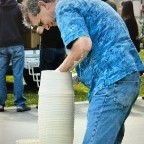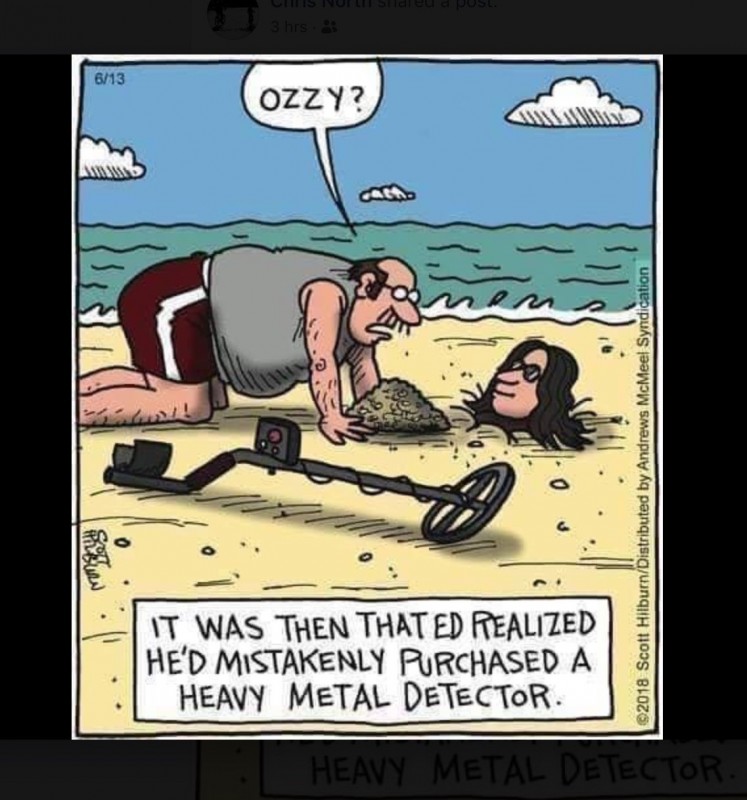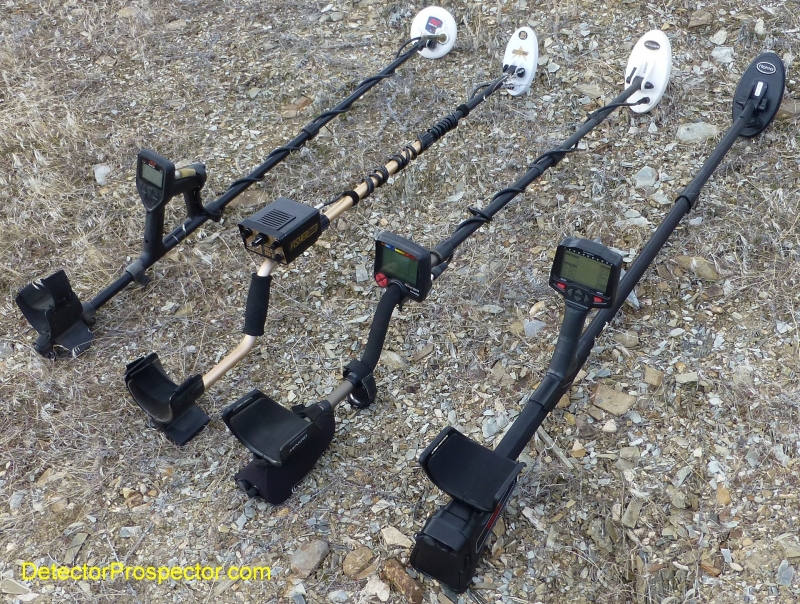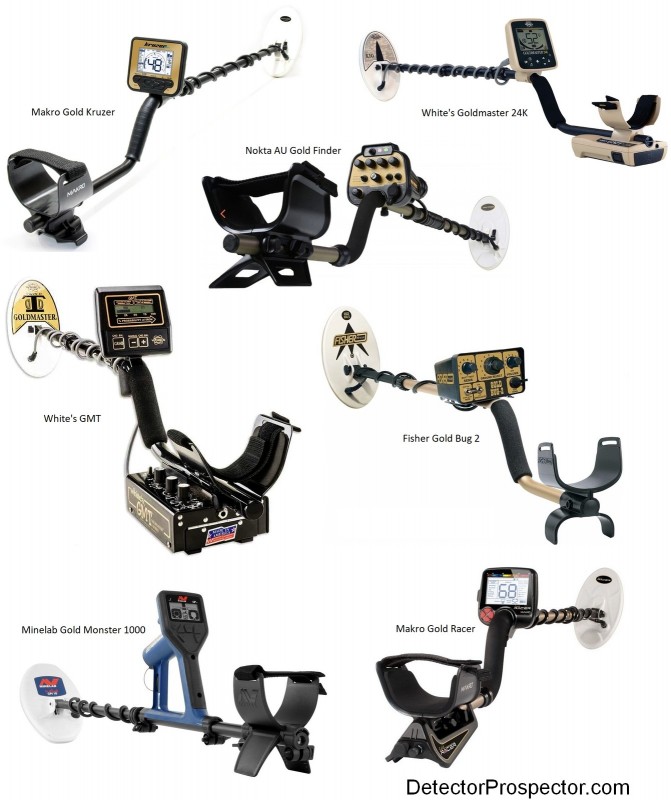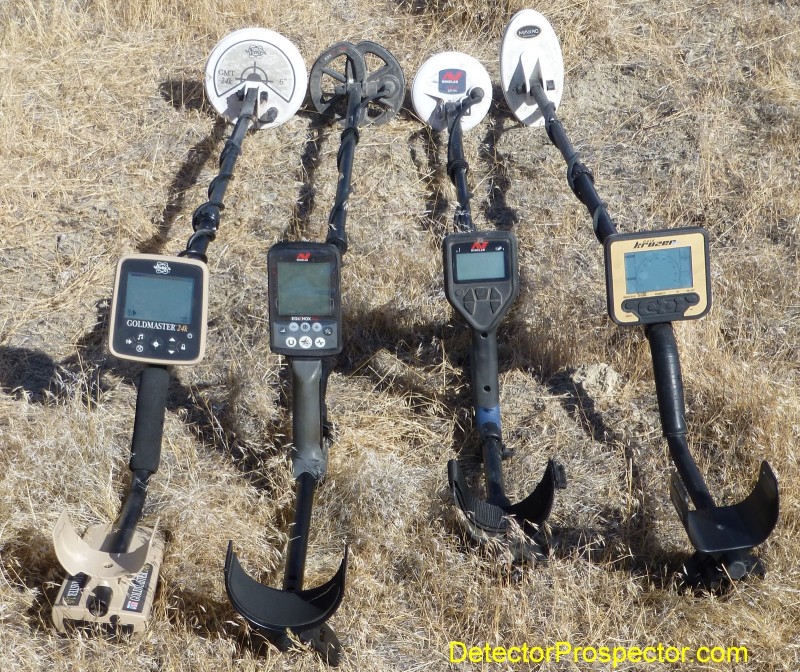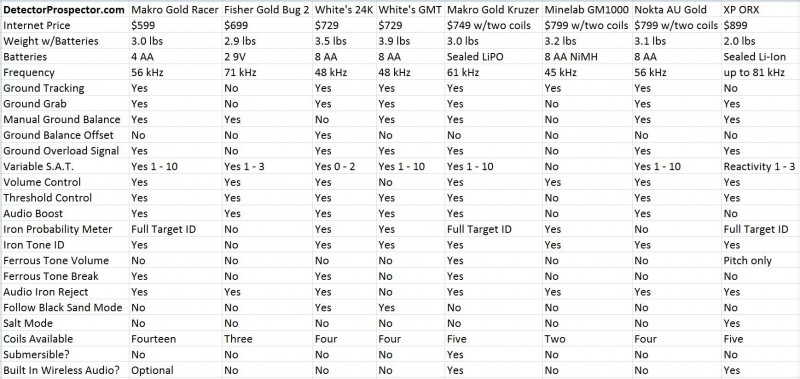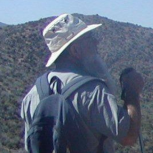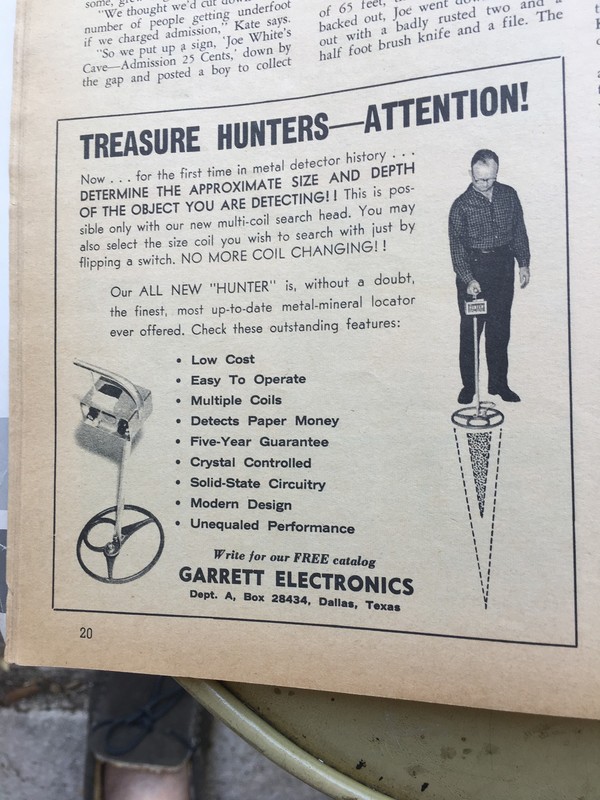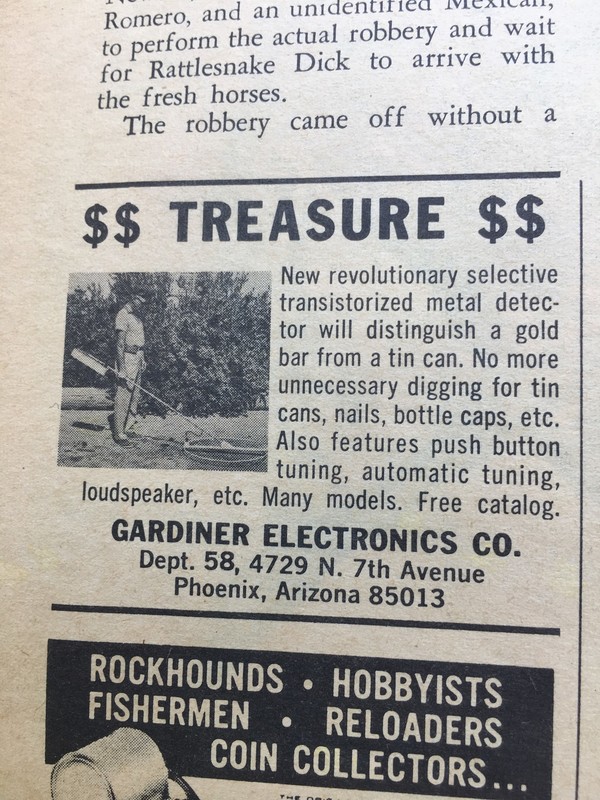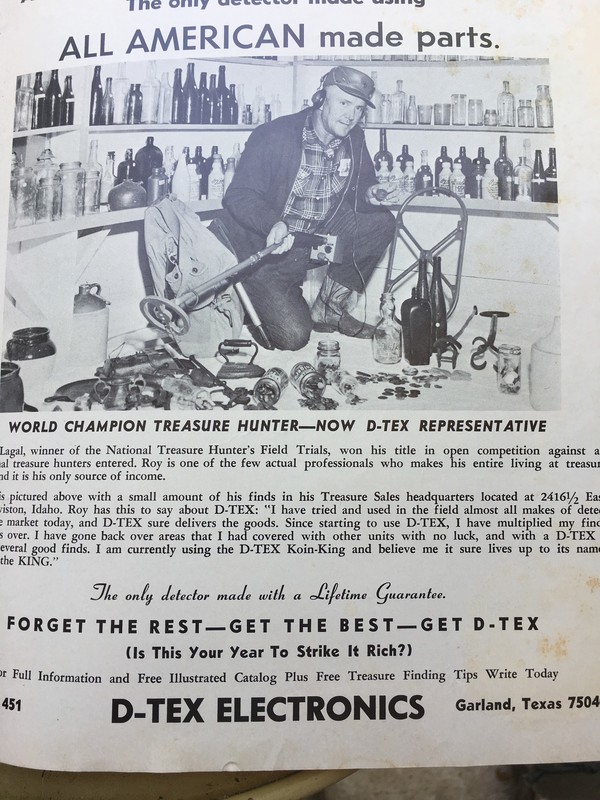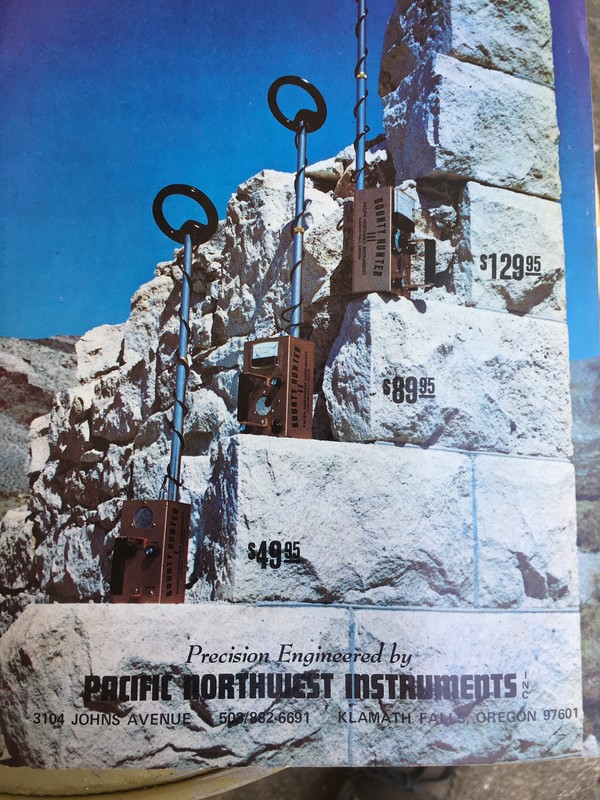Search the Community
Showing results for tags 'detector tech'.
-
I always have my ears perked up for something new in metal detectors and metal detecting technology. I’m not educated enough to really get deep into the technical side of it, but I have a general layman's knowledge of the subject. A couple years ago Carl Moreland, the Engineering Manager for White's Electronics, was interviewed on a radio show. I tripped over a reference to the interview on another forum and checked it out. It is very long, and near the end Carl dropped a bombshell. At least I thought so, but it went unnoticed and uncommented on in the metal detecting online world. I thought about posting it on a forum back then but decided to wait and see what developed. Here is the applicable portion of the interview: Relic Roundup Radio Show, January 17, 2012, Interview with Carl Moreland, Engineering Manager, White’s Electronics http://en.1000mikes.com/app/archiveEntry.xhtml?archiveEntryId=260469 Transcript beginning at 50:57 mark: Carl Moreland - “I can mention one technology that we’re working on because the patent has already been published… or the application, not the patent hasn't gone through yet. We’re working on something called half sine technology, which has actually been around since the 1960’s in geophysical prospecting applications. This is where instead of transmitting a sinusoidal signal you actually just transmit half of the sine and you can do that at extremely high voltages and high ? rates and so on. It’s technically not pulse induction but it’s not VLF either and it is a time domain method. And with that we can get really good depth and we can even get target id information and do discrimination and so forth.” Can you see why I perked up at that? I am still amazed it did not get any notice at the time. Nothing happened for a long time. Then I got this PM from Rick Kempf recently: Sent 29 January 2014 - 09:04 AM Was looking for info on my new SD 2100 this AM when I sort of fell down a rabbit hole of old forum posts and emerged reading Whites new patent. About the first thing I noticed was that you were cited in "prior art". Here's what they cited: http://www.voy.com/76600/7/475.html The patent is here: http://www.google.com/patents/US20110316541 Is this something you knew about? Just wondering. Rick Kempf I told Rick, yeah, heard about that. It was the patent finally being granted from the application Carl mentions in the interview. It was fun getting a mention in a patent though I think it was just the examiner studying up on the subject and finding my old post helpful in simplifying the subject. For a long time the Holy Grail in metal detecting has been something that combines the target identification of an Induction Balance (IB or more commonly known as VLF) detector with depth of a Pulse Induction (PI) detector. There have been many promises and false starts over the years, and that was one reason I kept the radio interview mention quiet the last couple years. Frankly, I had half forgot about it until Rick brought the patent being granted to my attention. Notice the title: Hybrid Induction Balance/Pulse Induction Metal Detector A new hybrid metal detector combines induction balance and pulse induction technologies. Target signals are generated from a transmitted wave that has both induction balance and pulse current inducing characteristics and uses pertinent sampling of the receive data. Combining the two data sources provides eddy current target identification while excluding ground permeability and remanence obscuration. Is it time to sing Hallelujah? Well, there is a big gap in between getting a patent and bringing a detector to market. Many patents get filed and you never even see something directly related to the patent. Maybe it looked good on paper but does not pan out well in reality for numerous reasons. So just because White's was granted this patent does not mean something is around the corner. However, they have been working on it for over two years already obviously. And it has been some time since White's put something new out. I do not count remakes of the MXT etc as new. So I think there is reason to be hopeful we may see something one of these days. John Earle is one of the unsung heros in the industry. He had a hand in many of the best products at Compass Electronics before moving over to White's after Compass went under. To this day I have never used a VLF that goes any deeper than my old Compass Gold Scanner Pro. John was one of the brains involved in that, as well as the White's Goldmaster 3, regarded by many as being the pinnacle of the analog development of that model line. I was fortunate to have met John at the factory some years ago. He is listed as the inventor on the new patent. Half sine technology is also mentioned in an earlier patent filed by White's, again with John listed as inventor at http://www.freepatentsonline.com/7649356.pdf Looks like serious stuff brewing. Bruce Candy of Minelab makes mention of half sine technology in a patent application at http://patents.com/us-20130154649.html which makes me wonder about the new "Super Gold Detector" he is working on. But it is this most recent patent by White's that seems to put the finest point on it. Maybe the Holy Grail of detecting is soon to be a reality. The fact it is White's certainly gives me more hope than what we have seen in the past. Edit May 2015 - see also White's patent for Constant Current Metal Detector
-
-
Today I tried something different, trying to cherry pick only deep high tones. Had the 6 inch coil on my 800, very trashy small 100+ year old park. Set it on Park 1, noise cancel, manual GB, 5 tones with the first 3 segments set to 0 volume 1 tone the last 2 were both set to max volume and tone, set the recovery speed at 5 and 0 iron bias. My question to those that know is, am I losing depth with this kind of setting? It seemed to work well, I have been trying to figure out how to park hunt deep silver,.All the pieces in the image were only giving tone, no numbers and were all carrot deep. Suggestions?
-
Not saying all but most comparison is between the Equinox and whatever they want to show off. I’ve seen this video between the Equinox and the New Anfibio before. The funny thing is he put the Anfibio in deep mode to do the testing . Is someone telling me I got to put the Anfibio in this mode to get the most depth. My thinking is when I turn a detector on and set the sensitivity as high as I can get it to run that’s as deep it’s going. I guess with it I hunt this field with the regular settings then go back and hunt it in the deep mode. I say Bull Sh-t ! Have you notice that most never say what the ID is showing. I’d like to see and I’m sure some are out there testing against their own detectors. I guess over in the U.K. maybe you want to hear a fair to good tone at fifteen inches. Just maybe the ID is not important to you but to me it is . Give me a detector that shows a good ID at 6 to 10” and that’s all I’ll ask for . If beyond that it don’t give me a ID then it’s up to me to dig are not. I did like the tone when it detected something . On hearing some others it was like scratching on a black board . So many times the person doing the testing never had a Equinox in their hands before. I could take and nail a coffee can lid on to a broom handle to make the other something less if the need be . Chuck PS Why don’t you just let your detector stand on it’s own.
-
High Frequency Gold Nugget Detector Roundup Our cup runneth over! Just a few years ago the market for "over 30 kHz nugget detectors" was quite limited. For a long time there were only a few options: Fisher Gold Bug 2 (71 kHz) $764 with one coil Minelab Eureka Gold (6.4, 20, & 60 kHz) Discontinued $1049 when new with one coil White's GMZ (50 kHz) Discontinued $499 when new with one coil White's GMT (48 khz) $729 with one coil Things were that way for over a decade. Then in 2015 Makro introduced the Gold Racer (56 kHz) $599 with one coil. Sister company Nokta released the AU Gold Finder (56 kHz) $799 with two coils Then in 2017 we see the Minelab Gold Monster 1000 (45 khz) at $799 with two coils. And although not a dedicated nugget detector, the Deus high frequency coil options (up to 80 kHz) were also released, $1520 for complete detector with one HF coil. Now in 2018 we get another general purpose machine, the Equinox 800, that can hit 40 khz, $899 with one coil. And just announced... the Makro Gold Kruzer (61 kHz) $749 with two coils and the White's Goldmaster 24K (48 khz) $729 with one coil These last two announcements have made barely a ripple in the prospecting world, or at least going by other forums that seems to be the case. There are various reason for that (forums not being prospecting oriented or being Minelab centric) but still the lack of buzz is interesting. I do believe people are both burned out by all the new introductions and that the market is saturated with high frequency models. Leaving out the general purpose machines to sum up the current options it looks like the current "sweet spot" for pricing is a high frequency model at $749 with two coils. The Gold Bug 2 saw a price reduction to $699. Makro Gold Racer 56 kHz - $599 one coil Fisher Gold Bug 2 71 kHz - $699 one coil White's Goldmaster 24K 48 kHz - $729 one coil White's GMT 48 khz - $729 one coil Makro Gold Kruzer 61 kHz - $749 two coils Minelab Gold Monster 1000 45 kHz - $799 two coils Nokta AU Gold Finder 56 kHz - $799 two coils Added 1/2019 XP ORX up to 81 kHz - $899 one coil High frequency nugget detectors compared White's Goldmaster 24K, Minelab Equinox 800, Gold Monster 1000, Makro Gold Kruzer Minelab Gold Monster, Fisher Gold Bug 2, Makro Gold Racer, Nokta Impact
-
When I saw a video showing the Makro Gold Racer recovery speed using two nails and a gold ring, it caused me to reflect on the various internet nail tests. Nearly all employ modern round nails, when these items rarely present issues. The common VDI (visual discrimination scale) puts ferrous items at the low end of the scale, and items with progressively increasing conductivity higher on the scale. The problem is the size of items also matters. Small gold is low on the scale, and the larger the gold, the higher it reads on the scale. A silver quarter reads higher than a silver dime, etc. All manner of ferrous trash including medium and smaller nails fall where they should when using discrimination and are easily tuned out. The problem is large iron and steel items, and ferrous but non-magnetic materials like stainless steel. Steel plates, large bolts, broken large square nails, axe heads, hammer heads, broken pry bar and pick tips, etc. all tend to read as high conductive targets. Usually it is just the sheer size pushing it higher up the scale. Detectors also love things with holes, which makes for a perfect target by enabling and enhancing near perfect eddy currents, making items appear larger than they really are. Steel washers and nuts are a big problem in this regard, often reading as non-ferrous targets. Oddball shapes cause problems, particularly in flat sheet steel. Old rusted cans often separate into irregular shaped flat pieces, and roofing tin (plated steel) and other sheet steel items are my number one nemesis around old camp sites. Bottle caps present a similar issue in modern areas. These items produce complex "sparky" eddy currents with both ferrous and non-ferrous indications. Many thin flat steel items produce remarkably good gold nugget type signals in old camp areas. Two general tips. Concentric coils often handle ferrous trash better than DD coils. A DD coil is often the culprit when dealing with bottle caps where a concentric coil often makes them easy to identify. Another thing is to use full tones. Many ferrous items are producing both ferrous and non-ferrous tones. Blocking ferrous tones allows only the non-ferrous tone to be heard, giving a clear "dig me" signal. This was the real bane of single tone machines with a simple disc knob to eliminate ferrous objects. You still heard the non-ferrous portion of the signal. Multi tones allows you to hear the dual ferrous/non-ferrous reports from these troublesome items, helping eliminate most of them. Certain detectors can also show multiple target responses on screen at once, like the White's models featuring the SignaGraph (XLT, DFX, etc.) and CTX with target trace. These displays show target "smearing" that stands out differently from the clean VDI responses produced by most good items. A machine with a simple VDI numeric readout can only show you one number at a time and the only indication you might get is "dancing" numbers that refuse to lock on. Usually though the predominate response overrides and fakes you out. This is where a good high end visual display capable of putting all VDI response on screen simultaneously can really help out. the bottom line is there is not a clear line between ferrous and non-ferrous, but an overlap. Many detectors offer a variable control to deal with this - the iron bias setting. Higher settings eliminate more ferrous, but also runs more risk of missing the desired non-ferrous. Conversely, lower settings reduce the risk of missing desired targets, but you dig more trash. I have been collecting these odd iron and steel items to practice with and to help me evaluate which machines might do best in ferrous trash. The main thing I wanted to note here is contrived internet videos with common round nails often present a misleading picture. Many machines do very well on nails yet fail miserably on flat steel. Steel Trash Testing Tech explanation from Laurence Stamatescu at Minelab:
-
We see new detectors on the market that offer to run in one frequency at a time. They have several to offer like the new XP ORX. In my opinion I think they can come back at a later day and have a update that could give you a multi frequency to run at one time like the Nox. Back in time it was turn on and go but as we all know today that don’t hold true anymore. That detector has a brain that we can access and I say if I set it up before for a change then I can come later to make that change. I want your opinion so lay it on me . Chuck
-
The big thing one detector company open up in 2018 is a milt frequency. You can pick one at a time are all numbers at one time. I believe that all other detector companies has to make this their goal too . I know this is putting the cart before the horse but what frequency numbers do you want to see in the new White’s in 2019 ? I myself want it more for coin hunting. I still would like to see some high numbers. I want it for small gold if I find myself on a beach are in the gold fields . Yes I do want to pick what I want to hunt in be one are all . I hope someone from White’s will chime in just to say they haven’t forgot about us faithful ones . Chuck
-
I wonder if Minelab will build a dedicated nugget detector in the style of the equinox, but with gpz type technology. This seems to be the way the CZX by Fisher is headed. I think the Equinox will open up many more machines in the same style eventually. I would hope for concentric and dd coils and more power in a lightweight dedicated nugget hunting package.
-
A nice summary quote from Tom Dankowski about why Simultaneous Multi Frequency (SMF) is worth consideration over single frequency options... “SMF's punch through bad dirt better. Hold on to accurate ID's at depth....and in bad dirt....better. Handle EMI better. Genuinely handle wet-salt better..... to include more accurate ID at depth.,.,.,.,.,.,.,., and a host of other rationale/justifications.” Fisher Intelligence (5th Edition) by Thomas J. Dankowski
-
While experimenting with my Gold Racer, I think I saw more stable VIDs by raising the coil and scanning perpendicular to magnetic north. There seemed to be a height that was most stable, and scanning perpendicular to magnetic north tended to eliminate oscillation between very low and very high values. It wasn't perfect, but it was suggestive. I'm wondering if anyone else has anything to offer about this.
-
First Texas (Bounty Hunter, Fisher, Teknetics) - last new models Fisher F75+ and Teknetics T2+. Next up a new pulse induction (PI) beach detector. A new digital multifrequency to replace the Fisher CZ3D is long overdue but at this rate we will be lucky to just see the PI before the end of the year. Garrett - last new model the AT Max. Hard to believe the flagship GTI 2500 has been around since 1999 with no updates. Garrett so far has shown no interest in multifrequency. The most I was hoping for was a lightweight dry land version of the ATX, but so far no sign of that happening either. I doubt we will see anything else from Garrett this year but they could surprise. Makro - last new models the Multi Kruzer and Gold Kruzer. Makro has mastered single frequency so everyone would like to see what they can do with multifrequency or pulse induction. I expect Makro is done with new models for the year. Minelab - last new models Equinox 600 and 800. I have no idea what’s up next for detectors but I sure would like to see that small coil for my GPZ 7000. I really don’t expect anything new for the rest of the year besides Equinox accessories. Nokta - sister company to Makro. Last new detector the Nokta Impact. Up next the Nokta Anfibio. Tesoro - Who? What? White’s - last new models the MX7 and TDI SL Special Edition plus the just announced Goldmaster 24K. Hopefully that new tech will eventually see the light. Right now just getting the 24K out the door is job one. XP - last new products the HF coils for the Deus, with X35 coils and XP Orx due by end of year.
-
Hi, I am looking to purchase a gold finding metal detector that can handle mineralized soil well, but also locates smaller gold. I live in southern Nevada and it seems that the more I read, the more confused I am getting. I guess I'm looking for a detector that does well with tiny and larger gold. I had the Gold Bug 2 for a while and it was way too sensitive for me and not rain-proof. The Makro Gold Kruzer, The Gold Monster and others on that level are all within my price range, so I am having trouble making a decision. I understand that the right detector for someone may not be the right detector for someone else, but I do believe the right input is valuable. I haven't seen any head to head videos using the Gold Kruzer yet (still too new) but it looks promising so far. The reviews of these detectors are great, but nothing beats real world testing under various conditions and soil types. I am not one for air testing due to it's controlled nature, so the confusion grows. I know many of these detectors can locate tiny gold due to their higher kHz, but there is a trade off. I appreciate any suggestions. Thank you, Mike
-
Steve's Law of Target Depletion - All good locations with high value targets will be detected with progressively more aggressive means until no metal can be found. When any location contains items of great perceived value, detector technology will normally be applied in reverse order of aggressiveness. First will be VLF discrimination "cherry picking". This will be followed by varying degrees of "turning down the discrimination" to dig iffy targets and then on to using the barest of ferrous/non-ferrous discrimination. This will finally be followed by "all metal" detecting to remove masking effects with either VLF or PI detectors. If the location is considered good enough all targets will eventually over time be completely removed until no detector is able to acquire a target. At this point a site may be considered "hunted out" until a new technology arrives allowing for more depth or ground separation capability, when a few more remaining metal items will be removed. The key concept is that since discrimination is unreliable, all metal items must be removed from high value locations in order to rest assured nothing has been overlooked. Nugget hunters and beach hunters get right with the program. If a nugget "patch" is located it will be relentlessly pounded until no metal remains. Beaches survive to some degree by being a renewable resource but even on beaches the richer, older deposits of jewelry are worked out over time. Good relic locations can and will be subjected to the same attention given to nugget patches, detected relentlessly until no metal remains. The rule is that as long as you can find a piece of metal hope remains that good items can be found. If not you, somebody else can and will return until no metal remains. I have promoted PI detectors for all uses for this very reason for over 15 years now - see that last few paragraphs at www.losttreasure.com from 2005. Most people consider depth to be problem number one, but for many areas target masking is by far the more serious issue. Until detectors can actually see through trash instead of blocking it out, even the smallest surface trash can and will block deeper adjacent items from being detected. Superb discrimination only gets you so far and ultimately the only solution is to remove the surface trash to see what lurks below. The only real limitation we face in this regard is in areas sensitive to digging holes of any sort, like a well groomed park. Even there, slow careful extraction of surface trash over time can reveal old coins missed by others for decades. Beneath The Mask by Thomas Dankowski
-
Apparently there's a hidden analysis screen in the FBS machines that lead one to a spectrograph of sorts. Much like the V3i which has features hidden away from the end user, supposedly the analysis screen can be accessed via a button sequence that is yet to be discovered. http://metaldetectingforum.com/showthread.php?p=1912446 If you read through the thread, I'm iDetectorX in the last post. If this is a spectrograph it does tend to confirm what Geotech has been telling us all along, that FBS is actually a 2 frequency system in terms of what is actually demodulated and processed, which would be a better explanation in my view as to why it never made it to the end user. In any event, I think it would be an interesting challenge to try to access these hidden item. I'm actually in the process now of doing some experiments with 2 V3s and a V3i, but FBS machines interest me as well. ....ah, forbidden fruit.
-
can anyone give me a idea on what ratio or scale there is between different metals and depth with the same detector ....say made out of 6 different metals ... US nickel size coins .... silver , gold , alum , nickel , platinum ,steel and stainless steel ......
-
The following information is from an apparent leak from a First Texas distributor meeting? The link is posted at http://www.detectorprospector.com/forum/topic/555-new-fisher-pulse-induction-multi-frequency-detectors/?p=10571 as part of the thread about upcoming Fisher products that have been circulating for a couple years. These leaks seem to jive with previous statements by Tom Mallory of First Texas. The main one of interest to the people on this forum would be a new CZX model aimed at gold prospecting. Here is the text from the posted screen shot: CZX - Fisher and Teknetics This machine is ground breaking technology Turn on and go 2 frequency - 9:1 ratio No need to ground balance or adjust the detector to the environment It automatically senses the ground and makes changes accordingly. First detector birthed from this platform is a gold unit priced around $1000, but deeper than current VLF, this detector will also see through red dirt, and highly mineralized soil. From this platform other machines will develop. We intend to develop the CZX and MOSCA platforms to offer more machines in the $1000 to $2000 range than have ever been available. Target release 2016 We have senior engineer Dave Johnson on this project The "Mosca" platform referred to is further described and apparently is aimed more at being a general purpose non-prospecting detector (coins, jewelry, relics). Again, here is the text from the posted screen shot: "Mosca" Fisher and Teknetics Waterproof up to 10' (3 meters) Wireless headphones - Waterproof loop and connectors for headphones 2 frequency - 7:1 ratio Hobby/Treasure Market - Great for Saltwater, Relic, Coin Auto Ground Tracking Single Pod Design LCD Pad, control buttons, 2 AA batteries Arm Pad in rear Retail target - $1200 - $2000 Target release 2016 We have dedicated engineers on this project OK, so a gold unit around $1000 that goes deeper than current VLF designs. I also have high hopes that knowing the proclivities of the engineer, Dave Johnson, that it will be relatively light and ergonomic. Dave also prefers simple and the design statements reflect that. We seriously need something that brings gold detector weights and prices back to earth and so hopefully this will be it. I have stated over and over again I would be very happy with ATX equivalent performance in a less expensive lightweight package. Garrett so far seems disinclined to make that unit but they have a year at least before it may be a moot point. The CZX would have to obsolete the White's TDI as it is aimed squarely at or below the same price point and unless it beats TDI performance would be dead on arrival. We will not have long to wait - 2016 is coming fast!
-
Someone has X-rayed a equinox coil. Pretty good sized circuit board inside! https://md-hunter.com/minelab-equinox-coil-x-ray-is-it-really-the-half-of-machine/
-
Here's another, a second interesting product I've run into recently. This one has a bit of a giggle factor for me, but I could be wrong. See what you think.
-
Legendary metal detector engineer George Payne laid the foundations for much of what we consider to be modern metal detector technology. He or companies he worked for hold a host of basic patents. I tripped over this old lawsuit between White's Electronics and the old Teknetics company (acquired by First Texas in later years) over George's invention of basic target discrimination / target id technology. The following is from the public record of the legal findings at https://law.justia.com/cases/oregon/court-of-appeals/1984/677-p-2d-68.html: I thought it provided an interesting peek at some early industry history and so here you go..... Decided February 22, 1984. *69 J. Pierre Kolisch, Portland, argued the cause for appellant. With him on the briefs were Jon M. Dickinson, Francine H. Gray and Kolisch, Hartwell & Dickinson, Portland. Edward T. Monks, Eugene, argued the cause for respondents. With him on the brief were Kenneth A. Morrow, Morrow, McCrea & Divita, Eugene, and Gary S. Kindness, Seattle, Wash., of counsel. Before GILLETTE, P.J., and WARDEN and YOUNG, JJ. GILLETTE, Presiding Judge. Plaintiff White's Electronics, Inc. (White's) commenced this action seeking the imposition of a constructive trust for its benefit in all rights, patentable or otherwise relating to an invention developed by defendant George Payne. White's also sought an injunction restraining defendants from selling any product embodying such an invention and from using any trade secrets or other proprietary information belonging to plaintiff. The trial court denied White's any relief. We affirm. White's is a manufacturer of metal detectors. In 1969, White's hired Payne, an electrical engineer, to invent new metal detector technology. In 1971, Payne signed *70 an employment agreement with White's that stated that he would assign to White's any invention that he developed during and for six months after termination of his employment that related to White's activities or was the result of tasks assigned by it. During this period of employment, Payne assigned to White's two patents covering inventions pertaining to metal detectors. In mid-1976, he terminated his employment and went to work for Bounty Hunters, one of White's competitors. He remained there until late 1978, when he sought reemployment with White's. Because of a noncompetition agreement with Bounty Hunters, he did not become reemployed by White's until January, 1980. He did, however, work as a consultant for White's during the intervening period. When Payne was rehired, he did not sign a new employment agreement. As during his previous employment, he worked to develop innovations in the metal detector field and to solve problems related to White's product line. He assigned one patent to White's during this employment period. The evidence concerning the events of January, 1981, is both conflicting and confusing. Payne testified that on January 9, 1981, he conceived an idea that would enable a metal detector automatically to provide the user with target identifying information, unlike any detector then on the market. He stated that he told defendant Morris, White's marketing manager, of his idea, but that he did not work any further on its development until January 15, when he assembled a breadboard a board containing electrical circuits to test his idea. The breadboard failed to achieve the desired result. On January 17, 1981, following a period of internal management disruption at White's, Payne and Morris both quit. Payne testified that, on January 19, 1981, while working to develop his idea of January 9, he "found something that is going to make this thing work, or allow me to continue development of it." He stated that, following this "breakthrough," he still had to work for many more months before his concept was perfected. On January 28, 1981, Payne and Morris, along with defendant Smith, organized defendant Teknetics, Inc., to market metal detectors in direct competition with White's. In December, 1981, Teknetics introduced a metal detector which incorporated Payne's target-identification concept. Plaintiff contends that Payne's "breakthrough" on January 19, actually occurred earlier while he was still employed by White's. In support of this contention, plaintiff introduced Payne's engineering notes containing circuitry designs dated January 18, 1981. Payne admitted that the date on those notes was in error and that they were probably prepared sometime before the 18th. Plaintiff's expert, an electronics engineer, testified that he or someone similarly skilled could build a target-identification circuit based on the information provided in the drawing. Payne testified to the contrary, stating that the key element to his target-identification concept did not appear in his notes until January 19, after he had left White's employ. The trial court found that Payne conceived his target-identification concept on January 9, but that he did not exert time and effort to develop it until after January 17, the date he left White's employ. According to the court: "The idea achieved the status of invention sometime in March of 1981, as evidenced by the order for print out circuitry systems from another company. Prior to reaching this posture, [Payne] had to address himself to and solve problems of target identification as they related to ground rejection." The trial court concluded from the foregoing that plaintiff was not entitled to either the assignment of the patent or the imposition of a "shop-right." This appeal followed. Absent an agreement to the contrary, an employe who is hired to invent, and who succeeds during his term of service in accomplishing that task, is bound to assign to the employer all rights in the *71 invention. United States v. Dubilier Corp., 289 U.S. 178, 187, 53 S. Ct. 554, 557, 77 L. Ed. 1114 (1933); Mainland Industries v. Timberland Mach., & Eng., 58 Or. App. 585, 589, 649 P.2d 613, rev. den. 213 Or. 801 (1982), cert. denied ___ U.S. ___, 103 S. Ct. 1498, 75 L. Ed. 2d 930 (1983). Furthermore, the practice by an employe of assigning patents to an employer constitutes persuasive evidence of a duty to assign. Mainland Industries v. Timberland Mach. & Eng., supra, 58 Or. App. at 591, 649 P.2d 613. In this case, when Payne was rehired by White's in 1980, no new employment agreement was executed. Although Kenneth G. White, president of White's testified that he intended to rehire Payne on the same terms as his previous employment, the issue apparently was never discussed by the parties. The evidence is insufficient to support a conclusion that the 1971 agreement was revived by Payne's reemployment. However, even without an express agreement, we find that Payne was obliged to assign to White's inventions created during his employment. Payne was hired precisely because of his exceptional inventive abilities in the metal detector field. His duties were to invent and develop improvements in White's product line. This, in conjunction with Payne's practice of assigning patents to White's, including during his last period of employment, convinces us that he had a duty to assign all inventions arising during his employment. Thus, the central issue in this case is whether Payne's target-identification concept was sufficiently developed at the time he left White's employ so as to constitute an "invention" to which White's is entitled. Because White's is seeking the imposition of a constructive trust, it must prove its case by strong, clear and convincing evidence. Pantano v. Obbiso, 283 Or. 83, 87, 580 P.2d 1026 (1978). We are unable to find any Oregon cases dealing directly with this issue. Both sides cites numerous cases from other jurisdictions in which the term "invention" has been defined under a variety of factual circumstances. Most courts have adopted a definition which requires that an invention be something more than a thought in an inventor's mind. As stated in National Development Co. v. Gray, 316 Mass. 240, 55 N.E.2d 783 (1944): "Of course there is a distinction between the conception of an idea and the reduction of the idea into practice. The idea is only the starting point, and it does not become an invention until it is developed and perfected and becomes embodied in some tangible form which becomes some novel and useful device or process." 316 Mass. at 249, 55 N.E.2d 783. In Gray, on which plaintiff places great reliance, defendant Lawson, an employe of a company that manufactured shoe-heeling machinery, conceived of an idea for an improved model of that kind of machine while he was in that company's employ. Before he quit, he had reduced his idea to a drawing. The court ruled that, even though he had not yet constructed a working model of the machine, "* * * the idea had crystallized into such definite form by the time Lawson left the plaintiff's employment that he and those with whom he spoke concerning the new machine knew in a general way the principles governing its operation and its probable practical value. * * "It is plain from the evidence * * * that the drawing was the nucleus from which the machine emerged; that whatever Lawson accomplished up to the time he quit belonged to plaintiff, * * * that the activity of Lawson in reference to the new machine constituted a breach of his contract with the plaintiff; and that the latter was entitled to the patent." 316 Mass. at 250, 55 N.E.2d 783. We find the National Development Co. analysis helpful, but we reach a different result as an evidentiary matter. In our view, the evidence in the present case is not clear and convincing that the unsuccessful breadboard Payne assembled prior to his leaving White's employ was the "nucleus" *72 from which his target-identification concept emerged. We are not convinced that, at the time Payne left White's, his idea had "crystallized into a definite form." In fact, one of the key elements of the idea was not developed until after his resignation. When Payne left White's he left with an idea and a goal, but not with an invention. White's, therefore, is not entitled to a constructive trust or to assignment of the patent. White's argues that such a holding will encourage employed inventors deliberately to refrain from putting ideas into tangible form in order to circumvent employer's rights. Our response is that employers could protect themselves by requiring inventors to enter into contracts that provide that the employer is entitled to any inventions conceived during the term of employment and during a reasonable period of time after termination. In fact, White's required Payne to sign such an agreement during his first period of employment. Its failure to obtain such an agreement the second time around is fatal to its case. White's contends in the alternative that it is entitled to a "shop-right" in Payne's target-identification concept. A "shop-right" is a non-assignable license to a patent granted to an employer when an employe who works in a general or noninventive capacity creates an invention using the employer's time and materials. Mainland Industries v. Timberland Mach. & Eng., supra, 58 Or. App. at 593, 649 P.2d 613. Payne, however, was hired specifically as an engineer whose duties included inventing and developing improvements in White's product line. Thus, the facts do not warrant the application of the "shop-right" doctrine. White's final contention is that it is entitled to a permanent injunction to prevent defendants from using trade secrets, propriety knowhow or confidential information acquired from White's. Our review of the record does not reveal any evidence to support the granting of such an injunction. Affirmed.
-
Maybe this is a dumb question wit regard to PI machines why is that one machine will excel at small nuggets but can't do so well on bigger nuggets., Doesn't make sense to me. It would seem logical that iit can find small stuff big stuff should be easy?
-
Minelab Equinox will not be the detector of the year for ever. What will be next?
-
The ads came from mags dating back to 66. I can say I remember them all. Just maybe you remember some if not all. Chuck



